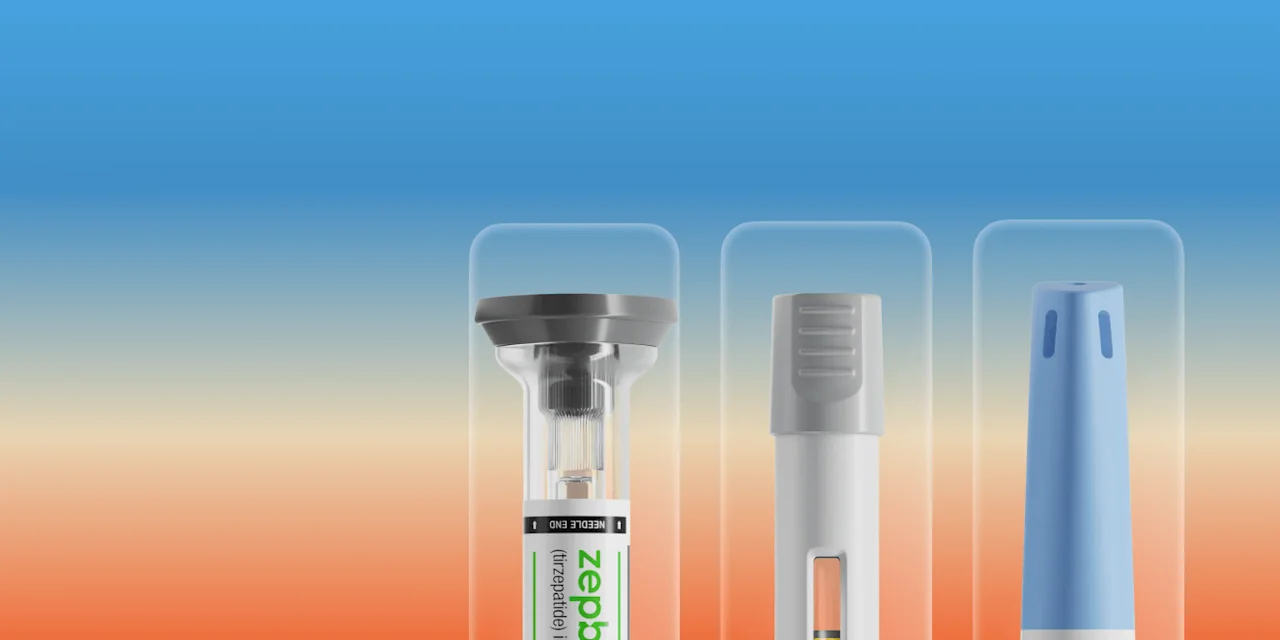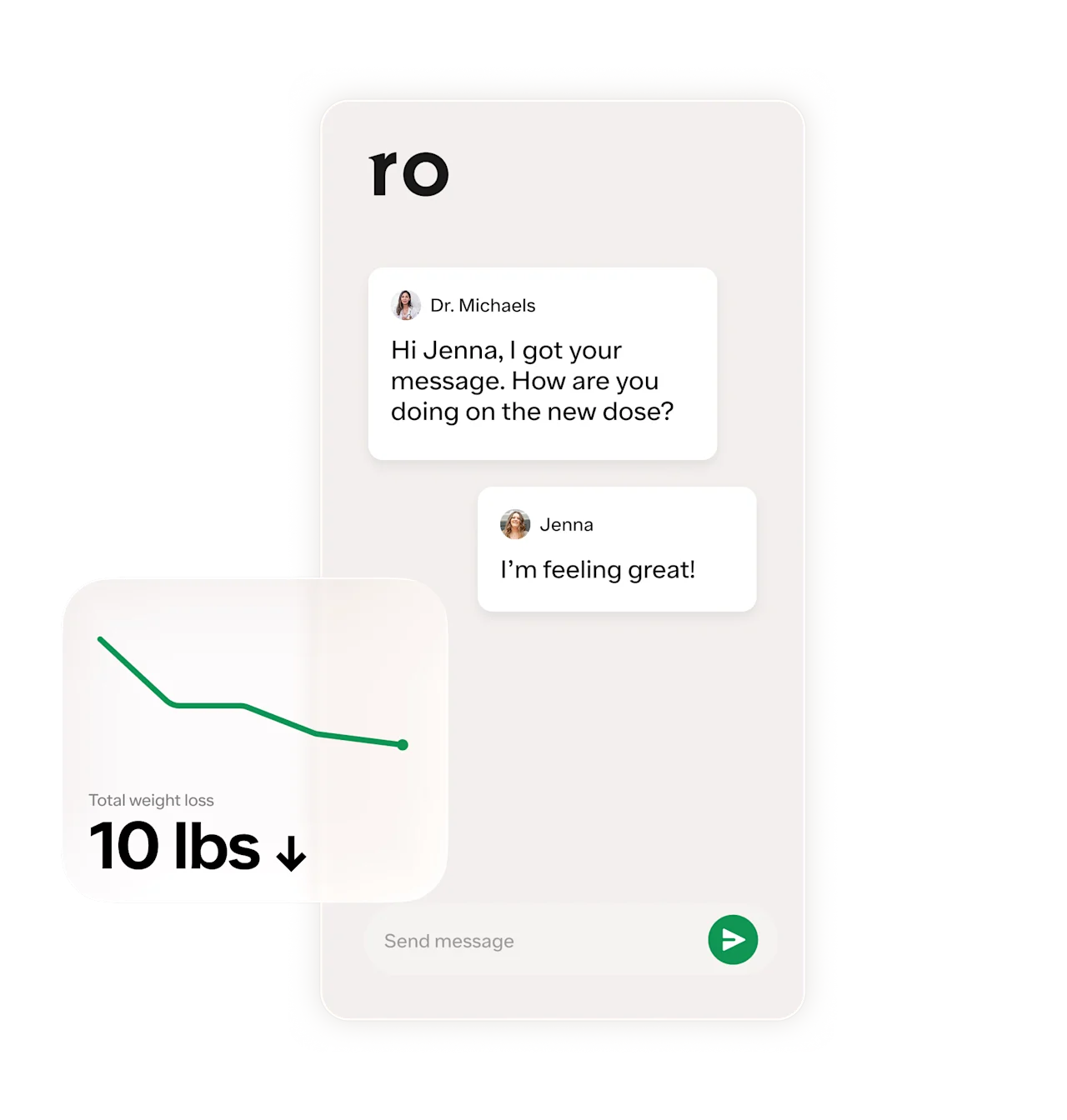Key takeaways
Wegovy is an FDA-approved medication for weight loss and cardiovascular risk reduction in people with overweight or obesity.
Clinical studies show people can lose around 15% of their body weight with Wegovy over 68 weeks.
Weight loss on Wegovy typically starts within the first month and is most significant when combined with a healthy diet and exercise.
Other factors, such as your starting weight, can also impact your specific weight loss results on Wegovy.
Here's what we'll cover
Key takeaways
Wegovy is an FDA-approved medication for weight loss and cardiovascular risk reduction in people with overweight or obesity.
Clinical studies show people can lose around 15% of their body weight with Wegovy over 68 weeks.
Weight loss on Wegovy typically starts within the first month and is most significant when combined with a healthy diet and exercise.
Other factors, such as your starting weight, can also impact your specific weight loss results on Wegovy.
If you’ve recently started taking Wegovy, you probably have lots of questions, starting with “What kind of Wegovy weight loss results can I expect, and how soon?” To answer that question, we reviewed the research and talked to clinicians.
Read on as we share an in-depth timeline of Wegovy weight loss results, complete with tips for managing side effects and making the most of the medication.
Getting started with Wegovy: the basics
Wegovy (semaglutide) is a once-weekly injectable prescription medication approved by the US Food and Drug Administration (FDA) to:
Reduce excess body weight and maintain weight reduction long term in adults and children aged 12 and older with obesity and adults with overweight and at least one weight-related health condition
Reduce the risk of major cardiovascular events (e.g. stroke, heart attack) in adults with cardiovascular disease and obesity or overweight
How Wegovy works
As a GLP-1 medication, Wegovy works by mimicking a gut hormone called glucagon-like peptide-1 (GLP-1). This hormone plays a role in regulating your blood sugar levels and appetite. More specifically, Wegovy works for weight loss by slowing down digestion, so you feel full sooner and eat less. At the same time, it targets brain receptors involved in appetite regulation, boosting your sensation of fullness and reducing your cravings for certain foods.
Weight loss timeline
In clinical trials, people taking Wegovy lost nearly 15% of their body weight — or 33 pounds — on average, within 68 weeks (about a year and a half). Wegovy begins working soon after you start taking it, and many people notice weight loss much sooner — around 6% at three months and nearly 11% at six months, according to some findings.
Wegovy-driven weight loss tends to stabilize after about a year, at which point the drug continues to help from a weight management perspective. Even so, people can continue losing weight on Wegovy after this point, albeit at a slower rate.
Wegovy weight loss before and after
Whittnie B., Ro ambassador, before Wegovy (left) vs. week four of Wegovy (right):

First two months of Wegovy weight loss results: week-by-week
Everyone’s weight loss journey is unique, and that still applies when you are taking Wegovy. Various factors can affect your results on the medication, from your starting body weight to any underlying conditions, such as type 2 diabetes. And Wegovy is meant to be a long-term medication for weight loss that works best when combined with other lifestyle changes like diet and exercise.
With those caveats out of the way, here’s a general idea of what you can expect during the first two months of taking Wegovy.
Week 1: Starting Wegovy
Wegovy comes in a prefilled pen that you inject under the skin of your thigh, abdomen, or upper arm once a week, on the same day each week. It comes in five dosage strengths: 0.25 mg, 0.5 mg, 1 mg, 1.7 mg, and 2.4 mg. Your healthcare provider will likely start you on the lowest dose (0.25 mg) to help your body get used to the medication and its side effects. Then, they will increase your dosage every four weeks until you reach a maintenance dosage (1.7 mg or 2.4 mg) that works for you.
During the first week of Wegovy, you probably won’t notice any changes in your body weight. Some people may experience some decrease in appetite, but most won’t notice it until they have increased their dose in the next month or two, says Alexander Dydyk, DO, director of weight loss and wellness at HealthyU Clinics.
What you will be more likely to experience, however, are the drug’s gastrointestinal side effects, especially nausea. The most common side effects of Wegovy include:
Diarrhea
Vomiting
Abdominal pain
Fatigue
For some people, these side effects may be mild. For others, they can feel intense. That’s why Shawn George, DO, an internal medicine physician at Yorktown Health Vernon Hills, recommends taking the time to figure out how to best manage them during the first week of taking Wegovy.
Tips for minimizing Wegovy side effects in the first week of treatment:
Make small, sustainable changes to your diet. As Wegovy starts to control your hunger signals, you may notice a small decrease in “food noise,” Dr. George says. He recommends two easy dietary changes during this time: increase your water intake and include one portion of non-starchy vegetables daily.
Avoid foods that worsen side effects. Drinking water can help relieve nausea, diarrhea, and constipation — and the same is true of consuming bland, easy-to-digest foods. In addition to these tactics, Dr. Dydyk recommends eating smaller portions, limiting fatty foods, and reducing your alcohol intake.
Exercise if you can, but rest if you need to. “When initially losing weight, you may notice some reduction in energy due to a reduction in the amount of calories you are eating,” Dr. Dydyk says. “This can make it challenging for exercise. That is okay. Your body will adjust.” If you’re up for it, Dr. George recommends short daily walks and gentle physical exercise to keep you moving during this phase.
Week 2: Managing side effects
During the second week of Wegovy, you’ll still be taking the lowest 0.25 mg dose. You’ve already lived with the side effects for one week. Now’s the time to continue finding ways to manage them while starting to build your new weight loss regimen. “The side effects typically improve over the course of the month, but they may also persist,” Dr. Dydyk says.
If you’re not feeling a reduction in appetite quite yet, don’t worry.
“Some people who take Wegovy are high responders [and] experience profound appetite suppression from the first dose,” Dr. Dydyk says. “Other people may have mild appetite suppression or none until they are on the higher doses of the medication.”
Tips for managing Wegovy side effects in the second week of treatment:
Eat smaller meals, more often. Wegovy is intended to be used with a reduced-calorie diet and exercise. “Reduced portion sizes are key to calorie reduction,” Dr. Dydyk says. Plus, eating smaller portions, more frequently, can help you avoid feeling too full and experiencing GI distress.
Increase your fiber intake. Fiber makes you feel full longer, making it easier to eat less as you adjust to a reduced-calorie diet on Wegovy. During the second week, incorporate more fiber-rich foods into your meals or consider a fiber supplement like psyllium husk. (If you’re experiencing a lot of diarrhea, hold off on this tip until your symptoms subside.)
Stay hydrated. Ample hydration is key to keeping nausea at bay, along with other troublesome Wegovy side effects like diarrhea and constipation. Plus, studies show that replacing beer or soda with water can lead to greater weight loss.
Week 3: Building momentum
By week three of Wegovy, you should feel like you know what to expect in terms of side effects. You might notice changes in your appetite, such as feeling full earlier during a meal, or having less food noise.
At this point, it’s important to start implementing the lifestyle changes that will support you throughout your weight loss journey and beyond.
Tips for building momentum during the third week of Wegovy:
Change your grocery shopping list. Moving forward, you want to eat healthy, nutritious foods that fill you up, rather than those with empty calories that leave you wanting more. Swap out processed items for whole foods high in fiber and protein.
Make time for meal planning. Meal planning makes it easier to ensure that you eat healthy during the week and get enough nutrition while losing weight. Plus, research shows that people who meal plan are less likely to have overweight.
Incorporate daily movement. Having a more active lifestyle beyond exercise further supports long-term weight loss. Opt to stand rather than sit, choose the stairs over the elevator, and park further away when doing errands.
Week 4: Establishing new healthy habits
During the first month of taking Wegovy, it’s especially important to establish new habits around food and exercise to support your long-term success, Dr. George says. He recommends tuning in to understand your body’s hunger and fullness cues. It’s common for people to eat out of habit or stress, but as you continue taking Wegovy, you may notice that your stomach simply doesn’t have room for all that food anymore.
Learning to listen to your body and eat only when you’re actually hungry can help you lose weight now — and keep it off in the future.
Tips for establishing new healthy habits during week 4 of Wegovy:
Wean off your usual snacks and find new favorites. Eating ultra-processed foods leads to weight gain. So, continue to step away from the processed foods and replace them with more nutritious options. Nuts and fruits are both great options, since their high-protein or -fiber content can fill you up and leave you satiated for longer.
Adjust how you eat, not just what you eat. Other habits can also support healthier weight loss on Wegovy, such as eating only when you’re hungry and stopping as soon as you feel full. Practicing mindful eating — where you eat without distractions — can make this easier to accomplish.
Schedule exercise. It’s easier to fit in exercise when it’s on your calendar. Make a plan for your workouts every week. You want to create a sustainable exercise routine that you can stick with.

Week 5: Increasing your dosage
Congratulations, you’ve officially made it through the first month of taking Wegovy! During the fifth week of treatment, your healthcare provider will likely increase your dosage to 0.5 mg.
At this point, the medication has reached a steady concentration in your bloodstream, and you may start to see more changes, Dr. George says. “During their meals, patients feel full earlier so they eat smaller amounts [and may see] a modest weight reduction.” In clinical trials, people lost a little over 2% of their body weight by week 5 of taking Wegovy.
Tips for managing side effects after your first dosage increase:
Stay on top of side effects. “Gastrointestinal discomfort that starts during week one usually disappears for some patients, but new digestive changes can occur when the dosage rises,” Dr. George says. Stay hydrated, avoid overeating, and avoid fatty foods that can worsen side effects.
Level up your exercise. Now that you’re in the second month, it’s time to seriously increase the duration of your workouts (e.g. add 10 minutes to your daily walk). In the second month of taking Wegovy, Dr. George starts his patients on a step-by-step exercise program that leads to 100 minutes of moderate exercise distributed across multiple days each week. You might also level up the intensity by adding a short jog or lifting weights.
Continue mindful eating. In addition to maintaining appropriate portion sizes, Dr. George recommends leaning into mindful eating during the fifth week of taking Wegovy. Avoid watching television or reading while you eat; instead, focus on each bite and how it tastes and feels.
Week 6: Maintaining healthy habits
At week six, your new habits should start to feel like integral parts of your lifestyle and routine. You may also notice physical changes in your body and continue to feel less distracted by food noise. Of course, you are still early on in your Wegovy dosage schedule and likely have a few more dosage increases ahead of you — each of which may accelerate the changes you’re experiencing.
Tips for maintaining healthy habits during week six of Wegovy:
Take up strength training. Weight training is key to preserving muscle tone while taking Wegovy — and making sure that the weight you lose is from body fat instead of muscle. Add in weight lifting or another form of resistance exercise (such as pilates or or yoga) three days a week.
Boost your protein intake. Eating more protein (or using protein powder) can help increase your metabolism, boost feelings of fullness, and get more power during your workouts. That’s why making sure to get enough of the macronutrient is important, especially at this point in your treatment, according to Dr. Dydyk. Dietary guidelines recommend getting at least 15%–20% of your daily calories from protein, or around 0.8–1.2 grams per kg of your body weight. If you aren’t already meeting those minimums, that’s a good place to start. But if you are, you might consider increasing that amount to about 25% of your daily calories for increased satiety.
Be kind to yourself. Changing just one habit is hard work, and you’re making a lot of changes all at once. If you miss a workout or have a bit too much to eat, don’t be too hard on yourself. You can pick things back up the next day!
Week 7: Optimizing weight loss
During week seven of Wegovy, you want to keep up the healthy habits — and push them a bit further. By now, you’ve built some muscle and endurance, so you’re more than up for it.
Tips for optimizing weight loss during week seven of Wegovy:
Amp up your exercise routine. The workouts you started doing at the beginning of treatment may now feel easy (or, at least, easier). Consider how you can amp up the intensity, from lifting heavier weights to swapping out one (or more) of your light jogs to a faster run.
Lengthen the time of your workouts. Health experts generally recommend a weekly minimum of 150 minutes of exercise (around 30 minutes for five days), but research suggests that working out more (up to 60 minutes) can drive more significant weight loss. So, if your sweat sessions are lasting closer to the half-hour mark, it might be worth spending more time — even if just 5–10 minutes to start — at the gym, depending on your goals.
Add in even more non-exercise movement. Increasing the amount of movement you do daily, outside of exercise, can make a big difference in your body composition. If you have a job where you sit often, set an alarm to stand up and walk for a few minutes every half-hour. You can also burn more calories by walking when you have a phone call or getting a walking pad under your desk.
Week 8: Staying motivated
Week eight will probably be your last injection at the 0.5 mg dosage strength. In clinical trials, people lost roughly 4% of their body weight by this point. So, you’ll likely be noticing changes in how your body looks and feeling pretty good about it! As you prepare for your next dosage increase, focus on keeping up the healthy habits you’ve established.
Tips for staying motivated during week eight of Wegovy and beyond:
Track your progress. Some people find it easier to stay motivated when they can see the results of the changes they’re making. Plus, this can help you stick with it as your new habits become your routine. You can use a fitness app or smartwatch to do this. Or you can keep it low-tech with a simple journal in which you note your daily movement (e.g. steps and exercise), daily calories, and weekly weigh-ins or waist measurements.
Find your community. Finding a weight loss “buddy” can make it easier to stick to your new habits. You can find these buddies IRL or online — many people taking Wegovy share their weight loss tips and success stories on Reddit.
Make aerobic exercise a daily thing. “A good goal would be 30 minutes of cardiovascular exercise daily, if possible, for cardiovascular fitness,” Dr. Dydyk says.
What happens after 8 weeks of Wegovy?
After the first two months of Wegovy, your healthcare provider will likely increase your dose again — this time to 1 mg per week.
“Most patients will now start to experience significant appetite suppression,” Dr. Dydyk says. “The majority of patients will begin to lose weight.”
As you continue your treatment with Wegovy, it’s important to stay hydrated. This can help you manage any side effects that may present with additional dose increases. “Adequate hydration is very important while on Wegovy, as well as making sure you are eating enough food and getting enough vitamins and nutrients in your diet,” Dr. Dydyk says.
Past the eight-week mark, you should continue to experience weight loss. After 12 weeks, people taking Wegovy reported less hunger and fewer cravings in one study. They were also eating about 24% fewer calories daily, leading to an average weight loss of 11 pounds, mostly from fat.
In another study that followed Wegovy users as they titrated up to the highest maintenance dose (2.4 mg), they were eating about 35% fewer calories at five months than when they started the weight loss medication. They also reported fewer cravings and better control over their eating. And, they had lost nearly 10% of their body weight.
How to maintain Wegovy weight loss results after 8 weeks
“Wegovy is a profound appetite suppressant,” Dr. Dydyk says, “but if there is not a focus on lifestyle change and nutrition, then patients are at risk of gaining weight when stopping Wegovy as they may return to old habits.” (That said, it’s still possible to regain weight even if you’ve mastered your new lifestyle changes. It's also worth noting that Wegovy is designed to be used long-term.)
With that in mind, here’s how to maintain Wegovy weight loss results after eight weeks and keep losing more.
Eat healthy
“Anyone on a medication designed to help with appetite suppression would benefit from a diet plan with a specific calorie target for weight loss,” Dr. Dydyk says. “A significant reduction in calories is the primary goal while on Wegovy.”
Since you’re eating less, it becomes even more important to ensure that the food that you’re eating is nutritious. Avoiding processed foods and beverages (think: anything high in sodium, saturated fats, and added sugars) is a smart choice. Instead, aim to fill up on whole foods high in fiber, protein, and healthy unsaturated fats. In particular, fiber- and protein-rich foods can increase feelings of fullness, so you’re less likely to snack out of habit.
Keep moving
Exercise is important throughout any weight loss process. It helps you build and preserve muscle, so you lose weight from fat instead. It helps you lose weight and keep it off. It even has a slight appetite suppressant effect.
To optimize your weight loss on Wegovy, adopt a regular exercise routine that includes both aerobic and resistance exercise. Outside of your workouts, find ways to sprinkle movement throughout your day, from taking the stairs to dancing around while you clean your house.
Make other lifestyle changes
Diet and exercise are both recommended when taking Wegovy. But there are other lifestyle changes you can make that support your slim-down journey.
Sleep better. Studies have linked obesity with poor sleep. On the other hand, people who get better sleep tend to lose more weight, according to a study of adults in a weight loss program. Aim to get 7–9 hours of sleep per night. Need help falling asleep? Practice good sleep hygiene, such as going to bed and waking up at the same time every day, avoiding caffeine, alcohol, and heavy meals later in the day, reducing your light exposure (including from electronics) in the evening, and taking up a regular meditation practice. And on that note…
Manage your stress. Stress is also linked to obesity, as well as poor sleep. And similar to obesity, people who find ways to reduce their stress tend to enjoy more weight loss success — along with a lift in their anxiety and depression. Stress management can take many forms, from therapy to yoga and meditation.
Bottom line
Wegovy produces exciting weight loss results, especially when paired with sustainable lifestyle changes. While the weight doesn’t fall off overnight, people who stay consistent often see meaningful results in a matter of months.
In clinical trials, most people lose about 2% of their body weight after the first month of Wegovy, with average weight loss reaching 15% after roughly a year and a half. Your Wegovy weight loss results may vary depending on factors like your diet, exercise, and starting weight.
Appetite suppression and reduced food noise typically begin within the first few weeks of taking Wegovy. This can make it easier to stick to a reduced-calorie diet and avoid mindless snacking.
Side effects like nausea and digestive issues are common in the early weeks to months of taking Wegovy. Learning how to manage them can improve your experience and help you stay on the medication.
People who adopt healthy habits like balanced eating and regular movement tend to lose more weight on Wegovy. These lifestyle changes also help sustain weight loss over the long term.
With Wegovy, continued weight loss is possible for up to two years. Hitting your maintenance dose and sticking with healthy routines can help you reach and keep your goal weight. Keep in mind, though, that everyone’s experience is different, and so, your weight loss results may taper off earlier.
Frequently asked questions (FAQs)
How much weight can you lose in a month on Wegovy?
The speed of weight loss on Wegovy can vary from person to person. But studies show that people may experience about a 2% reduction in their baseline body weight during the first month of taking Wegovy.
How quickly do you see weight loss with Wegovy?
Wegovy starts working soon after you start taking it. Even at the starting dose, people tend to notice appetite changes and a small amount of weight loss during the first month.
What to expect on week 5 of Wegovy?
By week five of Wegovy, the medication will have reached a steady state in your bloodstream. Your healthcare provider will also likely increase your dosage to 0.5 mg weekly, so you may experience an increase in side effects as well as reductions in your appetite, food cravings, and body weight.
How long do you take Wegovy for weight loss?
Wegovy is meant to be a long-term medication for weight loss and maintenance. How long you take Wegovy will depend on your weight loss goals, your tolerance for the medication, and any other lifestyle changes you make.
Do you lose weight on a maintenance dose of Wegovy?
Yes, you can lose weight on a maintenance dose of Wegovy. Most people don’t reach their maintenance dosage of Wegovy until four or five months, and studies show they can continue losing weight afterwards as well, although at a slower rate. Keep in mind, though, that every person is different, so experiences on Wegovy can vary.
DISCLAIMER
If you have any medical questions or concerns, please talk to your healthcare provider. The articles on Health Guide are underpinned by peer-reviewed research and information drawn from medical societies and governmental agencies. However, they are not a substitute for professional medical advice, diagnosis, or treatment.
Wegovy Important Safety Information: Read more about serious warnings and safety info.
GLP-1 Important Safety Information: Read more about serious warnings and safety info.
References
Akhlaghi, M. (2024). The role of dietary fibers in regulating appetite, an overview of mechanisms and weight consequences. Critical Reviews in Food Science and Nutrition, 64(10), 3139–3150. doi: 10.1080/10408398.2022.2130160. Retrieved from https://pubmed.ncbi.nlm.nih.gov/36193993/
Anam, M., Maharjan, S., Amjad, Z., et al. (2022). Efficacy of Semaglutide in Treating Obesity: A Systematic Review of Randomized Controlled Trials (RCTs). Cureus, 14(12), e32610. doi: 10.7759/cureus.32610. Retrieved from https://pmc.ncbi.nlm.nih.gov/articles/PMC9840940/
Baranwal, N., Yu, P. K., & Siegel, N. S. (2023). Sleep physiology, pathophysiology, and sleep hygiene. Progress in Cardiovascular Diseases, 77, 59–69. doi: 10.1016/j.pcad.2023.02.005. Retrieved from https://pubmed.ncbi.nlm.nih.gov/36841492/
Blundell, J., Finlayson, G., Axelsen, M., et al. (2017). Effects of once-weekly semaglutide on appetite, energy intake, control of eating, food preference and body weight in subjects with obesity. Diabetes, Obesity & Metabolism, 19(9), 1242–1251. doi: 10.1111/dom.12932. Retrieved from https://pmc.ncbi.nlm.nih.gov/articles/PMC5573908/
Cox, C. E. (2017). Role of Physical Activity for Weight Loss and Weight Maintenance. Diabetes Spectrum: A Publication of the American Diabetes Association, 30(3), 157–160. doi: 10.2337/ds17-0013. Retrieved from https://pmc.ncbi.nlm.nih.gov/articles/PMC5556592/
de Carvalho, K. M. B., Pizato, N., Botelho, P. B., et al. (2020). Dietary protein and appetite sensations in individuals with overweight and obesity: a systematic review. European Journal of Nutrition, 59(6), 2317–2332. doi: 10.1007/s00394-020-02321-1. Retrieved from https://pubmed.ncbi.nlm.nih.gov/32648023/
Dorling, J., Broom, D. R., Burns, S. F., et al. (2018). Acute and Chronic Effects of Exercise on Appetite, Energy Intake, and Appetite-Related Hormones: The Modulating Effect of Adiposity, Sex, and Habitual Physical Activity. Nutrients, 10(9), 1140. doi: 10.3390/nu10091140. Retrieved from https://pmc.ncbi.nlm.nih.gov/articles/PMC6164815/
Fresán, U., Gea, A., Bes-Rastrollo, M., et al. (2016). Substitution Models of Water for Other Beverages, and the Incidence of Obesity and Weight Gain in the SUN Cohort. Nutrients, 8(11), 688. doi: 10.3390/nu8110688. Retrieved from https://pubmed.ncbi.nlm.nih.gov/27809239/
Friedrichsen, M., Breitschaft, A., Tadayon, S., et al. (2021). The effect of semaglutide 2.4 mg once weekly on energy intake, appetite, control of eating, and gastric emptying in adults with obesity. Diabetes, Obesity & Metabolism, 23(3), 754–762. doi: 10.1111/dom.14280. Retrieved from https://pmc.ncbi.nlm.nih.gov/articles/PMC7898914/
Garvey, W. T., Batterham, R. L., Bhatta, M., et al. (2022). Two-year effects of semaglutide in adults with overweight or obesity: the STEP 5 trial. Nature Medicine, 28(10), 2083–2091. doi: 10.1038/s41591-022-02026-4. Retrieved from https://pmc.ncbi.nlm.nih.gov/articles/PMC9556320/
Ghusn, W., De La Rosa, A., Sacoto, D., et al. (2022). Weight loss outcomes associated with semaglutide treatment for patients with overweight or obesity. JAMA Network Open, 5(9), e2231982. doi: 10.1001/jamanetworkopen.2022.31982. Retrieved from https://jamanetwork.com/journals/jamanetworkopen/fullarticle/2796491
Gorgojo-Martínez, J. J., Mezquita-Raya, P., Carretero-Gómez, J., et al. (2022). Clinical Recommendations to Manage Gastrointestinal Adverse Events in Patients Treated with Glp-1 Receptor Agonists: A Multidisciplinary Expert Consensus. Journal of Clinical Medicine, 12(1), 145. https://doi.org/10.3390/jcm12010145. Retrieved from https://pmc.ncbi.nlm.nih.gov/articles/PMC9821052/
Hamano, S., Sawada, M., Aihara, M., et al. (2024). Ultra-processed foods cause weight gain and increased energy intake associated with reduced chewing frequency: A randomized, open-label, crossover study. Diabetes, Obesity & Metabolism, 26(11), 5431–5443. doi: 10.1111/dom.15922. Retrieved from https://pubmed.ncbi.nlm.nih.gov/39267249/
Kline, C. E., Chasens, E. R., Bizhanova, Z., et al. (2021). The association between sleep health and weight change during a 12-month behavioral weight loss intervention. International Journal of Obesity (2005), 45(3), 639–649. doi: 10.1038/s41366-020-00728-8. Retrieved from https://pmc.ncbi.nlm.nih.gov/articles/PMC7914147/
Kommu, S. & Whitfield, P. (2024). Semaglutide. StatPearls. Retrieved from https://www.ncbi.nlm.nih.gov/books/NBK603723/
Malaeb, S., Perez-Leighton, C. E., Noble, E. E., et al. (2019). A "NEAT" Approach to Obesity Prevention in the Modern Work Environment. Workplace Health & Safety, 67(3), 102–110. doi: 10.1177/2165079918790980. Retrieved from https://pubmed.ncbi.nlm.nih.gov/30370831/
Moon, J. & Koh, G. (2020). Clinical Evidence and Mechanisms of High-Protein Diet-Induced Weight Loss. Journal of Obesity & Metabolic Syndrome, 29(3), 166–173. doi: 10.7570/jomes20028. Retrieved from https://pmc.ncbi.nlm.nih.gov/articles/PMC7539343/
U.S. Food & Drug Administration (FDA). (2024). Highlights of Prescribing Information: Wegovy (semaglutide) injection, for subcutaneous use. Retrieved from https://www.accessdata.fda.gov/drugsatfda_docs/label/2024/215256s015lbl.pdf
Wilding, J. P., Batterham, R. L., Calanna, S., et al. (2021). Once-Weekly Semaglutide in Adults with Overweight or Obesity. New England Journal of Medicine, 384(11), 989–1002. doi: 10.1056/nejmoa2032183. Retrieved from https://www.nejm.org/doi/full/10.1056/NEJMoa2032183
Xenaki, N., Bacopoulou, F., Kokkinos, A., et al. (2018). Impact of a stress management program on weight loss, mental health and lifestyle in adults with obesity: a randomized controlled trial. Journal of Molecular Biochemistry, 7(2), 78–84. Retrieved from https://pmc.ncbi.nlm.nih.gov/articles/PMC6296480/














